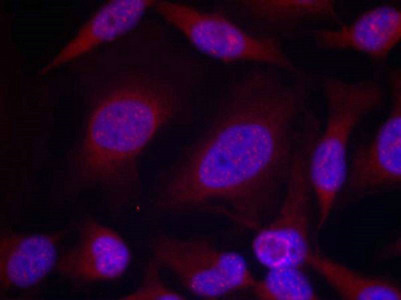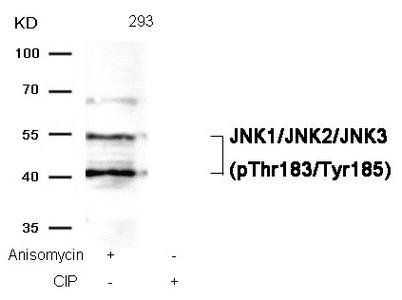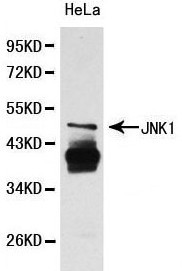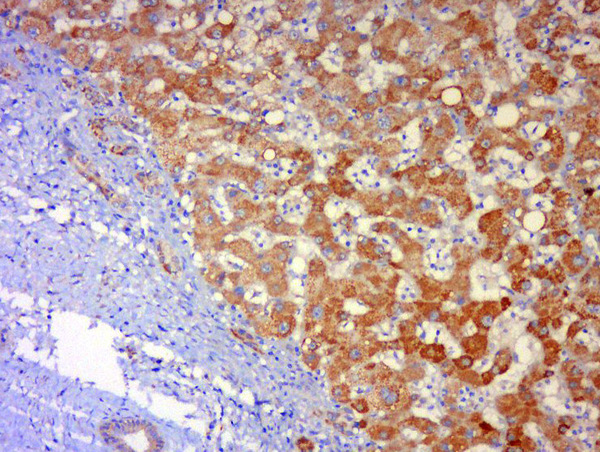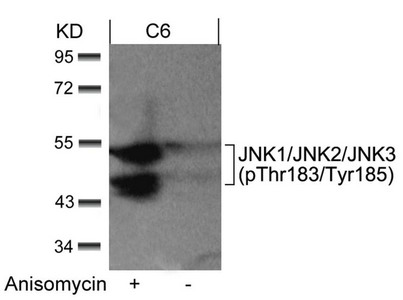
Western blot analysis of extracts from C6 cells untreated or treated with anisomycin using JNK1/JNK2/JNK3(phospho-Thr183/Tyr185) Antibody.
Phospho-MAPK8/MAPK9/MAPK10 (Thr183/Tyr185) Antibody
CSB-PA068484
ApplicationsImmunoFluorescence, Western Blot, ELISA
Product group Antibodies
ReactivityHuman, Mouse, Rat
TargetMAPK8
Overview
- SupplierCusabio
- Product NamePhospho-MAPK8/MAPK9/MAPK10 (Thr183/Tyr185) Antibody
- Delivery Days Customer20
- ApplicationsImmunoFluorescence, Western Blot, ELISA
- CertificationResearch Use Only
- ClonalityPolyclonal
- ConjugateUnconjugated
- Gene ID5599
- Target nameMAPK8
- Target descriptionmitogen-activated protein kinase 8
- Target synonymsJNK, JNK-46, JNK1, JNK1A2, JNK21B1/2, PRKM8, SAPK1, SAPK1c, mitogen-activated protein kinase 8, JUN N-terminal kinase, MAP kinase 8, c-Jun N-terminal kinase 1, stress-activated protein kinase 1, stress-activated protein kinase 1c
- HostRabbit
- IsotypeIgG
- Protein IDP45983
- Protein NameMitogen-activated protein kinase 8
- Scientific DescriptionResponds to activation by environmental stress and pro-inflammatory cytokines by phosphorylating a number of transcription factors, primarily components of AP-1 such as JUN, JDP2 and ATF2 and thus regulates AP-1 transcriptional activity. In T-cells, JNK1 and JNK2 are required for polarized differentiation of T-helper cells into Th1 cells By similarity. Phosphorylates heat shock factor protein 4 (HSF4). /Responds to activation by environmental stress and pro-inflammatory cytokines by phosphorylating a number of transcription factors, primarily components of AP-1 such as c-Jun and ATF2 and thus regulates AP-1 transcriptional activity. In T-cells, JNK1 and JNK2 are required for polarized differentiation of T-helper cells into Th1 cells. JNK2 isoforms display different binding patterns: a-1 and a-2 preferentially bind to c-Jun, whereas beta-1 and beta-2 bind to ATF2. However, there is no correlation between binding and phosphorylation, which is achieved at about the same efficiency by all isoforms. JUNB is not a substrate for JNK2 a-2, and JUND binds only weakly to it. /Responds to activation by environmental stress and pro-inflammatory cytokines by phosphorylating a number of transcription factors, primarily components of AP-1 such as c-Jun and ATF2 and thus regulates AP-1 transcriptional activity. Required for stress-induced neuronal apoptosis and the pathogenesis of glutamate excitotoxicity Davis, R.J. (1999) Biochem Soc Symp 64, 1-12. Ichijo, H. (1999) Oncogene 18, 6087-93. Kyriakis, J.M. and Avruch, J. (2001) Physiol Rev 81, 807-69.
- ReactivityHuman, Mouse, Rat
- Storage Instruction-20°C or -80°C
- UNSPSC41116161

